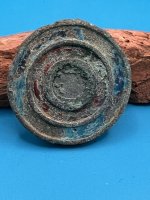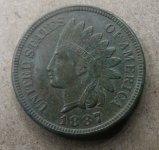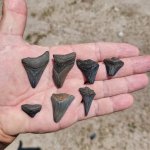- May 20, 2004
- 1,721
- 152
- Detector(s) used
- Minelab Excal 1000
- Primary Interest:
- All Treasure Hunting
By Brandie M. Jefferson, Associated Press Writer | July 15, 2006
BOSTON --Two schooners, each carrying 3,500 tons of coal, collided and sank off the Massachusetts coast in 1902.
The Frank A. Palmer and Louise B. Crary were waiting for the stormy December weather to clear before they rounded Cape Cod on their way to Boston.
The Crary's mate took off, trying to beat the Palmer, but miscalculated, sending his ship into the Palmer's port-side bow.
Between the two vessels, which both originated in Virginia, there were 21 men. Six went down with the ships. Fifteen made it to a lifeboat. Eleven were rescued four days later, 60 miles east of Cape Cod. Two more died after being rescued.
"It was a fairly harrowing story of survival for these nine remaining crew. They had no winter clothing, no food, no water and they are out there for four days in the extreme conditions," said Ben Cowie-Haskell, assistant superintendent of the Stellwagen Bank National Marine Sanctuary, where the ships went down.
More than 100 years later, the ships and the coal still sit at the bottom of the ocean, preserved by waters that hover just a few degrees above freezing, year round. But Saturday afternoon, anyone with an Internet connection could join an exploration and interact with marine researchers.
A collaboration between the National Oceanic and Atmospheric Administration, the National Undersea Research Center at the University of Connecticut and VBrick Systems Inc., made the Webcast possible.
NOAA researchers and NURC-UConn archeologists used technology -- including a remotely operated vehicle equipped with lights, cameras and lasers -- probed the wreck.
VBrick provided the broadcast equipment, allowing viewers to e-mail questions that were answered in real time using the same technology used to broadcast a similar exploration for Return to Titanic, a National Geographic special.
A University of Connecticut boat bobbed in the waters above the wreck while the remotely operated vehicle was lowered beneath the surface. Web viewers had a direct feed into the vehicle's camera as it circled the two ships.
Parts of the vessels remained well preserved -- a toilet reveals what one area must have been used for. But other areas, while the wood itself looked preserved, were more amorphous. Up close, parts of the vessels looked like submerged islands covered in flowers. The flowers were really sea anemones -- filter-feeding animals that have attached themselves to the wreckage.
Drawings and photographs of the original ships were shown alongside the broadcast images.
Ivar Babb, University of Connecticut researcher, and two NOAA archeologists narrated the scene.
Conspicuously absent from the cameras, however, were fish.
Aside from historic interest, "the other aspect of these wrecks that we want to investigate is the biology that grows on (them)," Cowie-Haskell said. "We are frankly surprised at how few fish we're seeing."
During one hour of diving, the camera picked up one codfish, and a few dozen juvenile redfish.
Trawlers are prohibited from the sanctuary, but recreational and commercial fishing is allowed. The area is about 840 square miles -- about 200 square miles smaller than the state of Rhode Island. Its western boundary is about 25 miles east of Boston, the southern boundary about three miles from Provincetown and the northwest boundary about three miles out from Gloucester.
The waters have historically supported a diversity of marine life, from humpback whales to endangered Kemp's ridley sea turtles.
One Webcast viewer asked via by e-mail what kind of artifacts the researchers had collected.
Babb said the teams don't take anything. That way, when they come back, they can monitor the degradation and learn how to better preserve other wrecks.
One of the last artifacts the cameras caught was a ceramic jug, looking surreal as it stood upright on the deck.
"Undoubtedly the survivors would have loved to take this with them," one of the narrators said, "but they did not have time to gather any provisions" as their ship quickly sank to the bottom of the ocean.
BOSTON --Two schooners, each carrying 3,500 tons of coal, collided and sank off the Massachusetts coast in 1902.
The Frank A. Palmer and Louise B. Crary were waiting for the stormy December weather to clear before they rounded Cape Cod on their way to Boston.
The Crary's mate took off, trying to beat the Palmer, but miscalculated, sending his ship into the Palmer's port-side bow.
Between the two vessels, which both originated in Virginia, there were 21 men. Six went down with the ships. Fifteen made it to a lifeboat. Eleven were rescued four days later, 60 miles east of Cape Cod. Two more died after being rescued.
"It was a fairly harrowing story of survival for these nine remaining crew. They had no winter clothing, no food, no water and they are out there for four days in the extreme conditions," said Ben Cowie-Haskell, assistant superintendent of the Stellwagen Bank National Marine Sanctuary, where the ships went down.
More than 100 years later, the ships and the coal still sit at the bottom of the ocean, preserved by waters that hover just a few degrees above freezing, year round. But Saturday afternoon, anyone with an Internet connection could join an exploration and interact with marine researchers.
A collaboration between the National Oceanic and Atmospheric Administration, the National Undersea Research Center at the University of Connecticut and VBrick Systems Inc., made the Webcast possible.
NOAA researchers and NURC-UConn archeologists used technology -- including a remotely operated vehicle equipped with lights, cameras and lasers -- probed the wreck.
VBrick provided the broadcast equipment, allowing viewers to e-mail questions that were answered in real time using the same technology used to broadcast a similar exploration for Return to Titanic, a National Geographic special.
A University of Connecticut boat bobbed in the waters above the wreck while the remotely operated vehicle was lowered beneath the surface. Web viewers had a direct feed into the vehicle's camera as it circled the two ships.
Parts of the vessels remained well preserved -- a toilet reveals what one area must have been used for. But other areas, while the wood itself looked preserved, were more amorphous. Up close, parts of the vessels looked like submerged islands covered in flowers. The flowers were really sea anemones -- filter-feeding animals that have attached themselves to the wreckage.
Drawings and photographs of the original ships were shown alongside the broadcast images.
Ivar Babb, University of Connecticut researcher, and two NOAA archeologists narrated the scene.
Conspicuously absent from the cameras, however, were fish.
Aside from historic interest, "the other aspect of these wrecks that we want to investigate is the biology that grows on (them)," Cowie-Haskell said. "We are frankly surprised at how few fish we're seeing."
During one hour of diving, the camera picked up one codfish, and a few dozen juvenile redfish.
Trawlers are prohibited from the sanctuary, but recreational and commercial fishing is allowed. The area is about 840 square miles -- about 200 square miles smaller than the state of Rhode Island. Its western boundary is about 25 miles east of Boston, the southern boundary about three miles from Provincetown and the northwest boundary about three miles out from Gloucester.
The waters have historically supported a diversity of marine life, from humpback whales to endangered Kemp's ridley sea turtles.
One Webcast viewer asked via by e-mail what kind of artifacts the researchers had collected.
Babb said the teams don't take anything. That way, when they come back, they can monitor the degradation and learn how to better preserve other wrecks.
One of the last artifacts the cameras caught was a ceramic jug, looking surreal as it stood upright on the deck.
"Undoubtedly the survivors would have loved to take this with them," one of the narrators said, "but they did not have time to gather any provisions" as their ship quickly sank to the bottom of the ocean.






